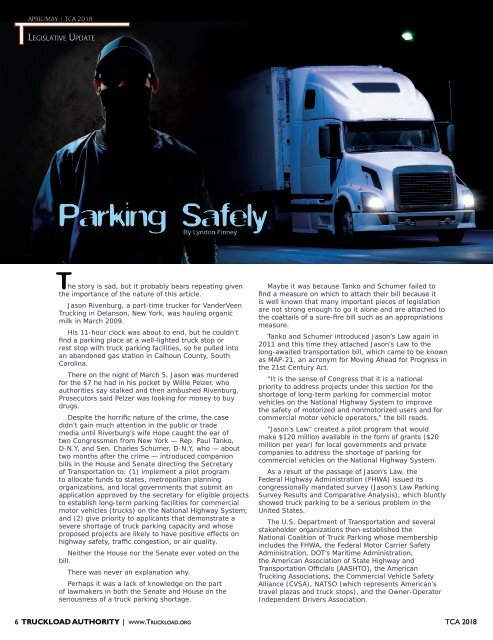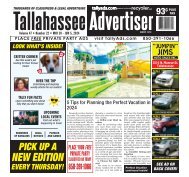TLA30_AllPages_RED
You also want an ePaper? Increase the reach of your titles
YUMPU automatically turns print PDFs into web optimized ePapers that Google loves.
APRIL/MAY | TCA 2018<br />
Legislative Update<br />
Parking Safely<br />
By Lyndon Finney<br />
he story is sad, but it probably bears repeating given<br />
the importance of the nature of this article.<br />
Jason Rivenburg, a part-time trucker for VanderVeen<br />
Trucking in Delanson, New York, was hauling organic<br />
milk in March 2009.<br />
His 11-hour clock was about to end, but he couldn’t<br />
find a parking place at a well-lighted truck stop or<br />
rest stop with truck parking facilities, so he pulled into<br />
an abandoned gas station in Calhoun County, South<br />
Carolina.<br />
There on the night of March 5, Jason was murdered<br />
for the $7 he had in his pocket by Willie Pelzer, who<br />
authorities say stalked and then ambushed Rivenburg.<br />
Prosecutors said Pelzer was looking for money to buy<br />
drugs.<br />
Despite the horrific nature of the crime, the case<br />
didn’t gain much attention in the public or trade<br />
media until Riverburg’s wife Hope caught the ear of<br />
two Congressmen from New York — Rep. Paul Tanko,<br />
D-N.Y, and Sen. Charles Schumer, D-N.Y, who — about<br />
two months after the crime — introduced companion<br />
bills in the House and Senate directing the Secretary<br />
of Transportation to: (1) implement a pilot program<br />
to allocate funds to states, metropolitan planning<br />
organizations, and local governments that submit an<br />
application approved by the secretary for eligible projects<br />
to establish long-term parking facilities for commercial<br />
motor vehicles (trucks) on the National Highway System;<br />
and (2) give priority to applicants that demonstrate a<br />
severe shortage of truck parking capacity and whose<br />
proposed projects are likely to have positive effects on<br />
highway safety, traffic congestion, or air quality.<br />
Neither the House nor the Senate ever voted on the<br />
bill.<br />
There was never an explanation why.<br />
Perhaps it was a lack of knowledge on the part<br />
of lawmakers in both the Senate and House on the<br />
seriousness of a truck parking shortage.<br />
Maybe it was because Tanko and Schumer failed to<br />
find a measure on which to attach their bill because it<br />
is well known that many important pieces of legislation<br />
are not strong enough to go it alone and are attached to<br />
the coattails of a sure-fire bill such as an appropriations<br />
measure.<br />
Tanko and Schumer introduced Jason’s Law again in<br />
2011 and this time they attached Jason’s Law to the<br />
long-awaited transportation bill, which came to be known<br />
as MAP-21, an acronym for Moving Ahead for Progress in<br />
the 21st Century Act.<br />
“It is the sense of Congress that it is a national<br />
priority to address projects under this section for the<br />
shortage of long-term parking for commercial motor<br />
vehicles on the National Highway System to improve<br />
the safety of motorized and nonmotorized users and for<br />
commercial motor vehicle operators,” the bill reads.<br />
“Jason’s Law” created a pilot program that would<br />
make $120 million available in the form of grants ($20<br />
million per year) for local governments and private<br />
companies to address the shortage of parking for<br />
commercial vehicles on the National Highway System.<br />
As a result of the passage of Jason’s Law, the<br />
Federal Highway Administration (FHWA) issued its<br />
congressionally mandated survey (Jason’s Law Parking<br />
Survey Results and Comparative Analysis), which bluntly<br />
showed truck parking to be a serious problem in the<br />
United States.<br />
The U.S. Department of Transportation and several<br />
stakeholder organizations then established the<br />
National Coalition of Truck Parking whose membership<br />
includes the FHWA, the Federal Motor Carrier Safety<br />
Administration, DOT’s Maritime Administration,<br />
the American Association of State Highway and<br />
Transportation Officials (AASHTO), the American<br />
Trucking Associations, the Commercial Vehicle Safety<br />
Alliance (CVSA), NATSO (which represents American’s<br />
travel plazas and truck stops), and the Owner-Operator<br />
Independent Drivers Association.<br />
6 Truckload Authority | www.Truckload.org TCA 2018

















